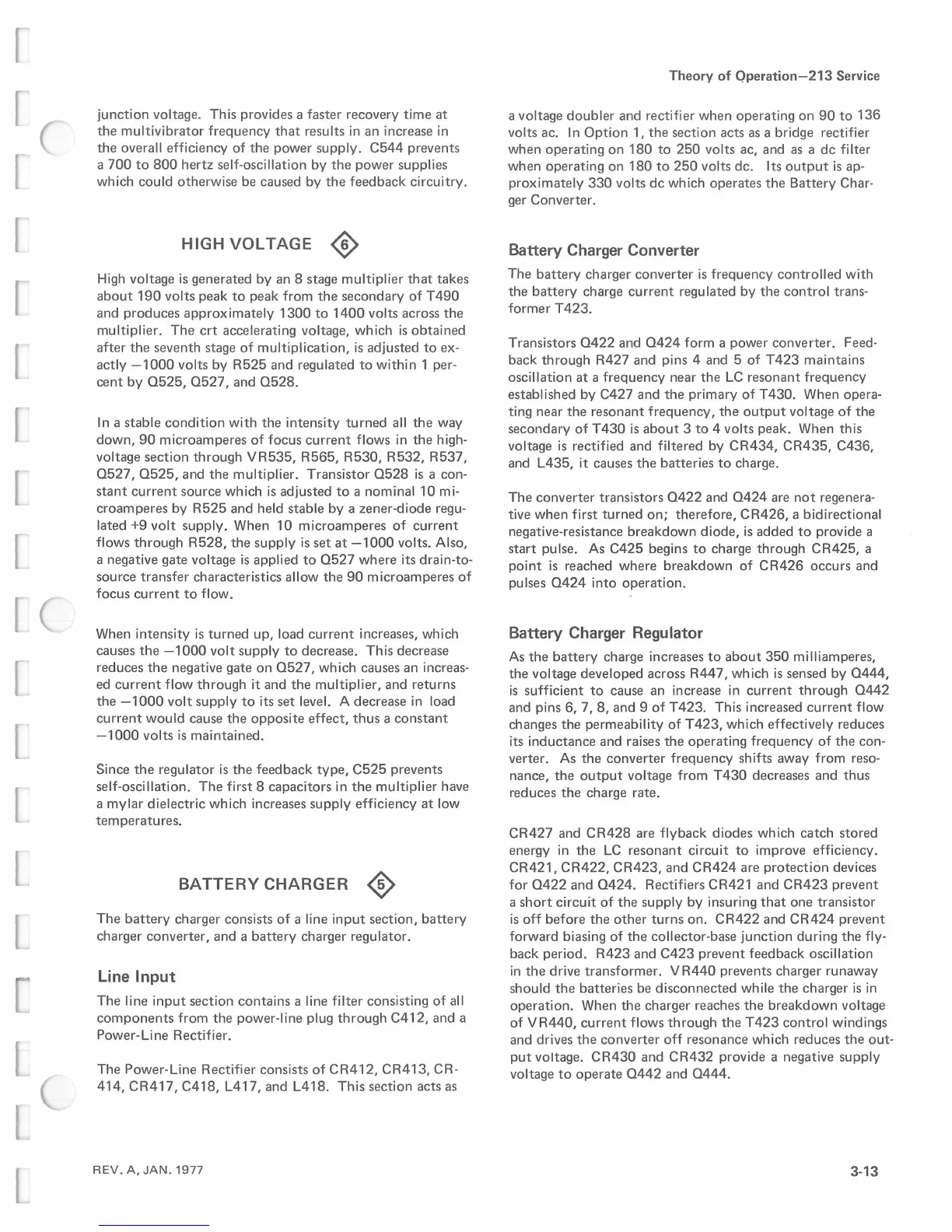junction
voltage. This provides a faster recovery time
at
the
multivibrator frequency
that
results
in
an increase
in
the
overall efficiency
of
the
power supply.
C544
prevents
a
700
to
800
hertz self-oscillation by
the
power supplies
which could otherwise be caused by
the
feedback circuitry.
HIGH VOLTAGE
~
High voltage
is
generated by an 8 stage multiplier
that
takes
about
190
volts peak
to
peak from
the
secondary
of
T
490
and produces
approximately
1300
to
1400
volts across
the
multiplier.
The
crt
accelerating voltage, which
is
obtained
after
the
seventh stage
of
multiplication,
is
adjusted
to
ex-
actly
-1000
volts by R525 and regulated
to
within 1 per-
cent
by
0525,
0527,
and
0528.
In
a stable
condition
with
the
intensity
turned
all
the
way
down,
90
microamperes
of
focus
current
flows
in
the
high-
voltage section through
VR535,
R565,
R530,
R532, R537,
0527,
0525,
and
the
multiplier. Transistor
0528
is
a con-
stant
current
source which
is
adjusted
to
a nominal
10
mi-
croamperes by
R525
and held stable by a zener-diode regu-
lated +9
volt
supply. When
10
microamperes
of
current
flows
through
R528,
the
supply
is
set
at
-1000
volts. Also,
a negative gate voltage
is
applied
to
0527
where its drain-to-
source
transfer
characteristics allow
the
90
microamperes
of
focus
current
to
flow.
When intensity
is
turned
up, load
current
increases, which
causes
the
-1000
volt supply
to
decrease.
Th
is
decrease
reduces
the
negative gate
on
0527,
which causes an increas-
ed
current
flow
through
it and
the
multiplier, and returns
the
-1000
volt
supply
to
its set level. A decrease
in
load
current
would
cause
the
opposite
effect,
thus
a
constant
-1000
volts
is
maintained.
Since
the
regulator
is
the
feedback
type,
C525 prevents
self-oscillation.
The
first 8 capacitors in
the
multiplier have
a mylar dielectric which increases supply efficiency
at
low
temperatures.
BATTERY CHARGER
~
The
battery
charger consists
of
a line
input
section,
battery
charger converter, and a
battery
charger regulator.
Line
Input
The
line
input
section
contains
a line filter consisting
of
all
components
from
the
power-line plug
through
C412,
and a
Power-Line Rectifier.
The
Power-Line Rectifier consists
of
CR412,
CR413,
CR-
414,
CR417,
C418,
L417, and L418. This section acts as
REV.
A,
JAN.
1977
Theory
of
Qperation-213
Service
a voltage
doubler
and rectifier when operating on
90
to
136
volts ac.
In
Option
1,
the
section acts
as
a bridge rectifier
when operating
on
180
to
250
volts ac, and
as
a
de
filter
when operating on
180
to
250
volts de. Its
output
is
ap-
proximately
330
volts
de
which operates
the
Battery
Char-
ger Converter.
Battery Charger Converter
The
battery
charger converter
is
frequency
controlled
with
the
battery
charge
current
regulated by
the
control
trans-
former
T423.
Transistors
0422
and
0424
form a power converter. Feed-
back
through
R427 and pins 4 and 5
of
T423
maintains
oscillation
at
a frequency near
the
LC
resonant frequency
established by C427 and
the
primary
of
T430. When opera-
ting near
the
resonant
frequency,
the
output
voltage
of
the
secondary
of
T430
is
about
3
to
4 volts peak. When this
voltage
is
rectified and filtered by
CR434,
CR435,
C436,
and L435, it causes
the
batteries
to
charge.
The converter transistors
0422
and
0424
are
not
regenera-
tive when first
turned
on;
therefore,
CR426,
a bidirectional
negative-resistance breakdown diode,
is
added
to
provide a
start
pulse. As
C425
begins
to
charge through
CR425,
a
point
is
reached where
breakdown
of
CR426
occurs and
pulses
0424
into
operation.
Battery Charger Regulator
As
the
battery
charge increases
to
about
350
milliamperes,
the
voltage developed across R44 7, which
is
sensed by
0444,
is
sufficient
to
cause an increase
in
current
through
0442
and pins 6, 7,
8,
and 9
of
T423.
This increased
current
flow
changes
the
permeability
of
T423,
which effectively reduces
its inductance and raises
the
operating frequency
of
the
con-
verter. As
the
converter
frequency shifts away from reso-
nance,
the
output
voltage from
T430
decreases and
thus
reduces
the
charge rate.
CR427
and
CR428
are fly back diodes which catch stored
energy
in
the
LC
resonant
circuit
to
improve efficiency.
CR421,
CR422, CR423,
and
CR424
are
protection
devices
for
0422
and
0424.
Rectifiers CR421 and
CR423
prevent
a
short
circuit
of
the
supply by insuring
that
one transistor
is
off
before
the
other
turns
on.
CR422
and
CR424
prevent
forward biasing
of
the
collector-base junction during
the
fly-
back period.
R423
and
C423
prevent feedback oscillation
in
the
drive transformer. V
R440
prevents charger runaway
should
the
batteries be disconnected while
the
charger
is
in
operation. When
the
charger reaches
the
breakdown
voltage
of
VR440,
current
flows
through
the
T423
control
windings
and drives
the
converter
off
resonance which reduces
the
out-
put
voltage.
CR430
and
CR432
provide a negative supply
voltage
to
operate
0442
and
0444.
3-13

